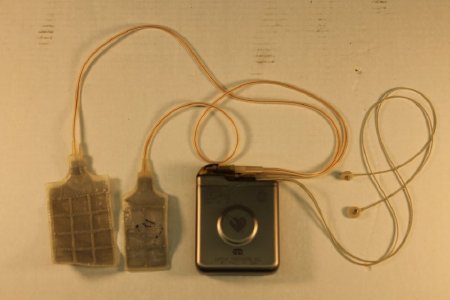Object ID Number:
2017.000.069
Object Name:
Pacemaker
Type:
Cardioverter Defibrillator
Manufacturer:
Cardiac Pacemakers, Inc.
Date of Manufacture:
/ /
Manufactured from:
1960
Manufactured to:
1990
Description / History:
Ventak Cardioverter Defibrillator developed by Cardiac Pacemakers Inc. c.late 1980s
This very large device would actually have been implanted within a patient, with the main console being lodged in a patient's stomach, and the mesh pads sewn onto the outside of a patient's heart. This model would have been programmed to offer a high energy electrical shock (in the same manner as external defibrillators we see on TV) to a patient's heart in the event of an unhealthily elevated heart rate.
This very large device would actually have been implanted within a patient, with the main console being lodged in a patient's stomach, and the mesh pads sewn onto the outside of a patient's heart. This model would have been programmed to offer a high energy electrical shock (in the same manner as external defibrillators we see on TV) to a patient's heart in the event of an unhealthily elevated heart rate.
Additional Information:
Pacemakers–devices which control abnormal heart rhythms by the emission of electrical pulses which prompt the heart to beat at a normal rate–have been around since the late 1950's. The earliest pacemakers were large, bulky devices which were attached to the outside of a person's chest, and contacted the heart with permanent wires inserted through the skin and attached to the surface of the heart.
By 1958, physicians in Sweden had succeeded in implanting the entire pacemaking device inside a patient's chest. Their first patient, a 40 year old man, was given a pacemaker whose battery failed in a few hours. The next pacemaker he was given lasted a few weeks, yet he was able to survive and receive yet another pacemaker in 1960, and he lived for 40 more years (and received 26 pacemakers in his lifetime).
The earliest pacemakers implanted were ungainly devices, powered by large zinc–mercury oxide batteries, delivered stimuli to the heart at a preset rate, regardless of the changing needs of the patient (whether the patient was running a marathon or asleep, the pacemaker ran at the same rate), and continued to deliver stimuli even when the patient's heart was working normally (a dangerous occurrence which could lead to heart failure).
In the late 1960's, however, physicians began developing pacemakers which were deactivated when the patient's heart was running normally. These pacemakers, known as ventricular inhibited (VVI) or ventricular triggered (VVT) were the dominant model from the mid–1960's to the early 1980's. In this exhibit, we have multiple pacemakers which function in this manner.
In the 1970's, the major developments in the pacemaker field included the introduction of lithium–based batteries (which allowed pacemakers to become markedly smaller), and the development of programmability. In the late 60's and early 70's pacemakers could have their rates adjusted only by surgical intervention. In 1972, however, pacemakers were introduced which could be manipulated without surgery, using just an external remote. These programmable pacemakers become almost universal by the 70's (note that most of the pacemakers in this exhibit are programmable), and are similar in this respect to modern pacemakers, which can be checked and manipulated over the phone, without a visit to the doctor.
